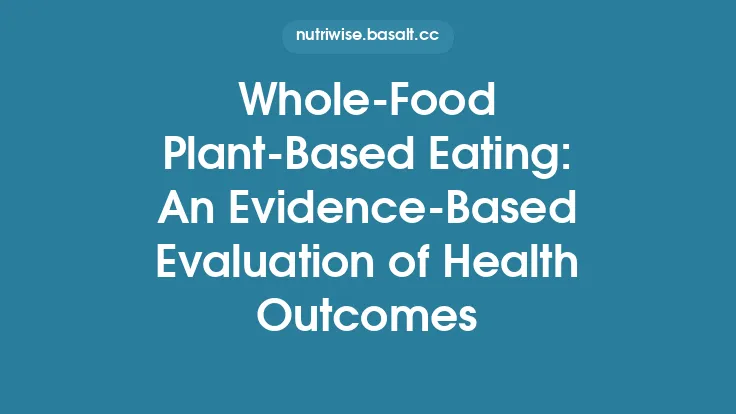Future‑proof eating means building a dietary approach that can adapt as scientific knowledge expands, especially in a field as dynamic as nutrigenomics. While the fundamentals of balanced nutrition remain stable, the way we understand the interplay between our genome and the foods we consume is evolving at a breakneck pace. This article outlines the emerging research trends, reliable ways to stay current, and practical mindsets that let you integrate new insights without being swept away by every headline.
Why Nutrigenomics Is a Rapidly Evolving Field
The genome is static, but the tools we use to read and interpret it are not. Over the past decade, three technological revolutions have accelerated nutrigenomic discovery:
- High‑throughput sequencing – Costs have dropped from $10,000 per genome in 2009 to under $100 today, allowing large, diverse cohorts to be genotyped.
- Multi‑omics platforms – Simultaneous measurement of transcriptomics, proteomics, metabolomics, and epigenomics provides a holistic view of how nutrients influence biological pathways.
- Artificial intelligence and cloud computing – Machine‑learning models can sift through billions of genotype‑phenotype‑diet data points, uncovering patterns that were previously invisible.
Because each new dataset can be re‑analyzed with improved algorithms, findings that seemed tentative a few years ago may become robust today. This fluidity makes staying current essential for anyone who wants to base dietary decisions on the best available science.
Key Emerging Research Themes
Multi‑Omics Integration
Traditional nutrigenomic studies focused on single‑gene variants and isolated nutrients. Modern research couples genomics with metabolomics (the “food metabolome”) to map how genetic differences alter the metabolic fate of whole foods. For example, a recent consortium study linked variations in the *FADS* gene cluster not only to fatty‑acid synthesis but also to downstream lipid‑derived signaling molecules that influence inflammation. Understanding these cascades helps predict long‑term health outcomes beyond simple nutrient absorption.
Polygenic Risk Scores (PRS) for Nutrition‑Related Traits
Instead of relying on one‑off SNPs, scientists are constructing PRS that aggregate the small effects of thousands of variants. Early PRS models predict susceptibility to diet‑related conditions such as non‑alcoholic fatty liver disease (NAFLD) or insulin resistance. While clinical implementation is still nascent, the methodology is maturing, and future updates will refine risk stratification for a broader set of metabolic phenotypes.
Gene‑Environment Interactions Beyond Food
Nutrigenomics is expanding to consider non‑dietary environmental factors—air quality, circadian disruption, and physical activity—that interact with genetic makeup. A landmark study demonstrated that the same *APOE* genotype confers different cardiovascular risk profiles depending on night‑shift work exposure. Recognizing these broader contexts is crucial for a truly “future‑proof” dietary strategy that accounts for lifestyle variables.
Nutrigenomics in Aging and Longevity
A growing body of work examines how genetic variants modulate the response to dietary patterns associated with healthy aging, such as the Mediterranean or plant‑forward diets. For instance, variants in the *SIRT1* pathway appear to influence how efficiently older adults metabolize polyphenols, potentially affecting cellular senescence markers. These insights are shaping the next generation of age‑specific nutrition guidelines.
Food‑Derived Bioactive Compounds and Gene Regulation
Research is moving beyond macronutrients to focus on phytochemicals, flavonoids, and other bioactives that can act as ligands for nuclear receptors (e.g., PPARs, LXR). Emerging data suggest that certain genotypes may amplify or blunt the transcriptional response to these compounds, opening avenues for “gene‑targeted functional foods” that are still in the experimental stage.
How to Track Cutting‑Edge Findings
Staying abreast of nutrigenomic advances requires a systematic approach rather than ad‑hoc browsing. Below are reliable channels and tools that filter noise and surface high‑quality evidence.
Scientific Journals and Preprint Servers
- Core Journals: *The American Journal of Clinical Nutrition, Nutrients, Nature Communications (Genomics section), and Cell Metabolism* regularly publish nutrigenomic research.
- Preprint Platforms: bioRxiv and medRxiv host early versions of studies. Look for papers flagged with “Nutrigenomics” or “Gene‑Diet Interaction” in the title or keywords.
Professional Societies and Conferences
- International Society of Nutrigenetics and Nutrigenomics (ISNN) – Annual meetings feature the latest methodological breakthroughs.
- American Society for Nutrition (ASN) – Their “Precision Nutrition” symposia often spotlight emerging genomic data.
Data Repositories and Open‑Access Platforms
- The GWAS Catalog – Updated weekly with new genome‑wide association studies, many of which include diet‑related phenotypes.
- MetaboLights and ArrayExpress – Host metabolomic datasets that can be cross‑referenced with genetic data.
AI‑Driven Literature Mining Tools
- Semantic Scholar’s “Research Explorer” – Allows you to set alerts for specific gene‑nutrient combinations.
- Iris.ai – Uses natural‑language processing to map concepts across papers, helping you discover hidden connections.
Evaluating the Quality of New Nutrigenomic Evidence
Not every headline reflects a robust discovery. Apply these criteria before integrating a finding into your dietary framework.
- Study Design – Randomized controlled trials (RCTs) with genotype stratification carry more weight than cross‑sectional surveys. Cohort size matters; larger, multi‑ethnic samples improve generalizability.
- Replication – Look for independent validation in separate populations. A single study, even if statistically significant, is insufficient for practice change.
- Population Diversity – Many early nutrigenomic studies were Eurocentric. Emerging research is expanding to African, Asian, and Latin American cohorts, which is essential for equitable application.
- Statistical Rigor – Check for correction for multiple testing (e.g., Bonferroni, FDR). Effect sizes should be reported alongside p‑values; a tiny p‑value with a negligible effect may be clinically irrelevant.
- Data Transparency – Open data and code availability enable independent re‑analysis, a hallmark of trustworthy science.
Translating Research Into Future‑Proof Eating Strategies
Building a Flexible Nutritional Framework
Instead of locking into a rigid “diet plan,” construct a modular system:
- Core Pillars – Whole foods, adequate protein, fiber, and healthy fats remain non‑negotiable.
- Adaptive Modules – Add or subtract specific food groups (e.g., fermented foods, cruciferous vegetables) as evidence emerges about their interaction with particular genetic pathways.
- Seasonal and Cultural Variability – Align modules with locally available foods to ensure sustainability and cultural relevance.
Modular Food Choices Aligned With Emerging Insights
When a new gene‑bioactive interaction is validated, you can incorporate it as an optional module rather than a mandatory rule. For example, if future research confirms that carriers of a *CYP1A2* variant benefit from higher intake of certain polyphenol‑rich berries, you might add “Berry Boost” as a weekly option without overhauling the entire eating pattern.
Continuous Learning Loop
- Monthly Scan – Set aside a brief period to review alerts from the AI tools or society newsletters.
- Quarterly Deep Dive – Pick one emerging theme (e.g., PRS for NAFLD) and read the primary literature, noting practical takeaways.
- Annual Review – Re‑evaluate your modular framework, retire outdated modules, and integrate validated new ones.
Ethical, Legal, and Social Implications of Rapid Advances
Data Privacy and Genetic Information
As more consumer‑focused nutrigenomic services appear, the line between research data and personal health data blurs. Ensure any platform you engage with complies with GDPR, HIPAA, or equivalent regional regulations, and that they provide clear consent mechanisms for data sharing.
Equity and Access
The current research pipeline is still skewed toward high‑income populations. Advocacy for inclusive study designs and public funding of nutrigenomic research can help prevent a widening health disparity where only a privileged few reap the benefits of cutting‑edge insights.
Regulatory Landscape
Regulators are beginning to address “genetic‑based nutrition claims.” Keep an eye on guidance from the FDA’s Center for Food Safety and Applied Nutrition (CFSAN) and the European Food Safety Authority (EFSA), as they will shape what information can be marketed to consumers.
The Role of Interdisciplinary Collaboration
Future breakthroughs will arise at the intersection of several fields:
- Bioinformatics – Development of more accurate predictive models for gene‑nutrient interactions.
- Clinical Nutrition – Translating model outputs into actionable counseling while respecting individual preferences.
- Food Science & Technology – Designing food matrices that preserve bioactive compounds and align with genetic responsiveness.
- Behavioral Science – Understanding how people adopt and maintain diet changes driven by genetic information.
Participating in cross‑disciplinary webinars or collaborative research consortia can provide a broader perspective and accelerate the translation of discoveries into everyday practice.
Preparing for the Next Decade of Nutrigenomic Discovery
Anticipated Technological Breakthroughs
- Single‑Cell Metabolomics – Will reveal how individual cell types within the gut respond to dietary components in a genotype‑specific manner.
- CRISPR‑Based Functional Screens – Enable high‑throughput testing of how knocking out specific genes alters nutrient metabolism, providing causal evidence.
- Wearable Metabolic Sensors – Coupled with genetic data, these devices could deliver real‑time feedback on how a meal is being processed at the molecular level.
Potential Shifts in Public Health Nutrition Policy
Governments may begin to incorporate polygenic risk information into population‑level dietary guidelines, moving from “one size fits all” to “risk‑adjusted” recommendations. Monitoring policy drafts and public comment periods will be essential for staying ahead.
Skills and Knowledge for Consumers and Professionals
- Data Literacy – Ability to interpret effect sizes, confidence intervals, and study design.
- Critical Appraisal – Recognizing hype versus evidence.
- Digital Tool Proficiency – Using reputable apps that integrate genetic data with evidence‑based nutrition modules.
Investing in these competencies now will make the transition to a more personalized, genomics‑informed food environment smoother.
Concluding Thoughts
Future‑proof eating is less about chasing the latest fad and more about constructing a resilient, evidence‑driven dietary system that can absorb new scientific insights without losing its core health benefits. By understanding the emerging research themes, employing disciplined methods to track and evaluate new findings, and maintaining an adaptable framework, you can stay aligned with the cutting edge of nutrigenomics while safeguarding long‑term nutritional well‑being. The genome may be immutable, but our knowledge of its interaction with food is anything but static—embrace the evolution, and let your plate evolve with it.





